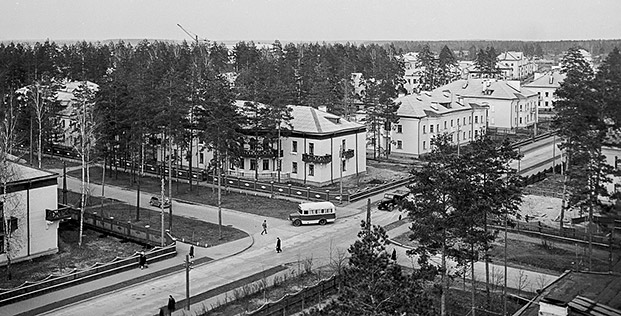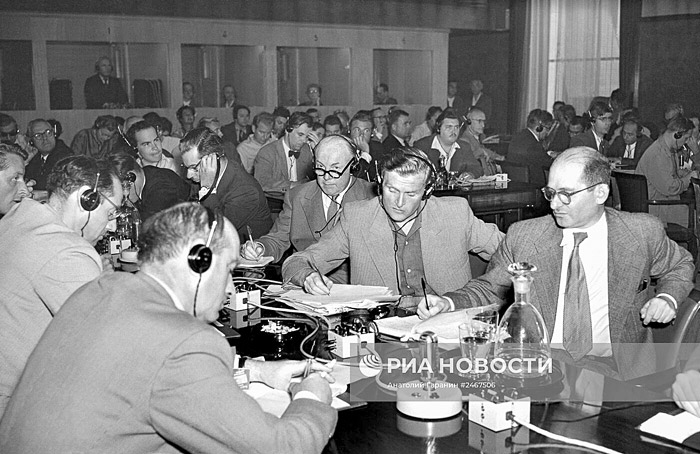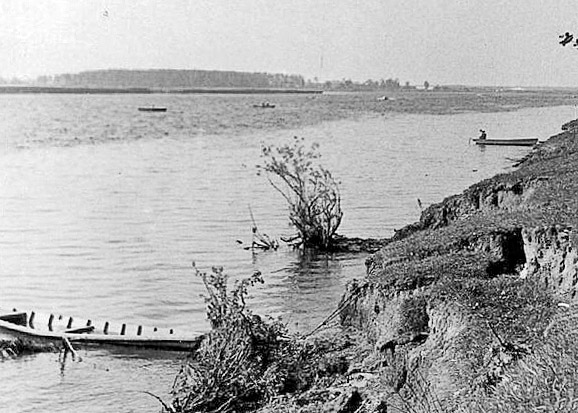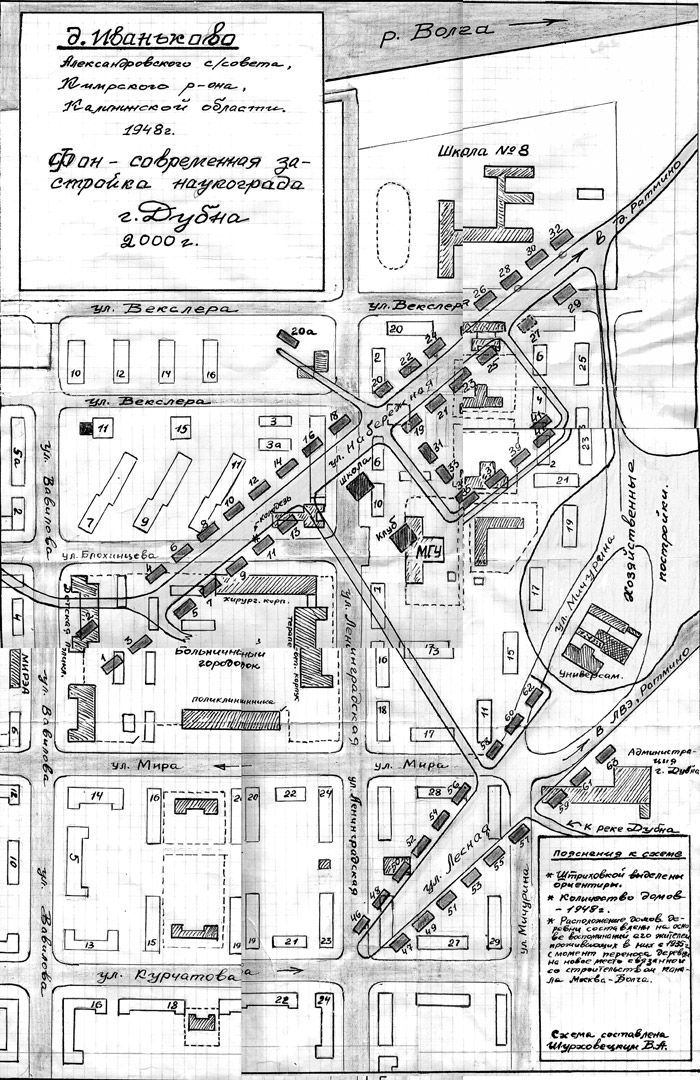
Electronic english version since 2022 |
The newspaper was founded in November 1957
| |
Historical overview
In anticipation of JINR
Institute Dubna - 1955
Residents of Dubna will never forget
labor enthusiasm of the first builders
Collection "Dubna 1956-1966"
Let's carry out a thought experiment: imagine that we, like the heroes of the film "Mirror for a Hero", stumbled upon some rusty wire sticking out of the ground and found ourselves in the 1955 Institute Dubna. (Actually, there is no other Dubna yet - modern Dubna, the city of fundamental science and the defense industry, appeared more than five years later, at the very end of 1960 and even then, firstly, only on paper).
Oh, they are making a movie, we would think, amazed at what we saw. Gloriously filmmakers have transformed the familiar landscape! The whole district of the Chernaya Rechka disappeared, as if it did not exist and it itself, not hidden in a pipe, smoothly carries its waters and flows at an acute angle somewhere near the water intake, just downstream. Across the river there are two bridges, railway and pedestrian.
 |
| From the memoirs of D.V.Shirkov: "MG looked like a young, energetic, prosperous general from science that he essentially was at that moment" |
In 1955, there is no longer a barrier on the Chernaya Rechka. The historical centre of the Institute Dubna has been developed. The administrative building stands in its usual place for the eyes - on a hillock, but so far without extension. The streets are also all in place, only unfamiliar names: Tsentralnaya, Shkolnaya, Parkovaya, Yuzhnaya, Peschanaya... only the name "Inzhenernaya" is familiar. Immediately behind Inzhenernaya there is Forced Labor Camp, the main labor force used in the construction of the future city of physicists. Behind him is the village of Novo Ivankovo.
In a two-story cottage opposite the old hotel, at the intersection of Parkovaya and Shkolnaya, the "head of the location" Comrade Meshcheryakov lives, the sovereign owner of the rapidly increasing town of physicists. There is a poem on the lists, the author of which wished to be anonymous:
- All of the people tremble in fear.
My voice makes the pine forest numb.
I want - and the Volga will go backwards,
And the miserable Caspian will become shallow. v I rule and my face shines with glory,
I am ready to stop all discontent.
Whoever is dissatisfied with me, let him flutters!
I am the leader of Ivankovo, M.G.Meshcheryakov!

The intersection of Tsentralnaya (Joliot-Curie) and Molodezhnaya Streets. Photo of TASS photojournalist A.S.Batanov. 1956
Next to the "leader of Ivankovo" is the cottage of his deputy, doctor of physical and mathematical sciences V.P.Dzhelepov. Further along Parkovaya Street - the cottages of the chief engineer A.V.Chestnoy and of the head of the accelerator operation department V.S.Katyshev. A year later, Chestnoy will go to Moscow, to the Kurchatov Institute and Katyshev will die in the summer of the same 1955 under circumstances that have not been fully clarified somewhere near Sukhumi, on the very first day of vacation and M.G.Meshcheryakov will especially regret this loss, remembering his first employees many years later. Katyshev's other neighbor is Bruno Pontecorvo, a world-famous physicist that disappeared in the autumn of 1950 and it inspired Agatha Christie's next detective novel "Destination Unknown".

On the alley leading to the old hotel
The declassification of nuclear physics in the Soviet Union is currently carried out, of course, in that part of it that is not related to defense tasks. The former "mailbox No. 1326" is now the working village of Dubno. The former Hydrotechnical Laboratory is now the Institute for Nuclear Problems of the Academy of Sciences, abbreviated INPAS.
The softening of the secrecy regime is noticeable throughout. Bruno Pontecorvo felt it for himself. Two people in the civil service stopped going after him anywhere and everywhere, with service weapons in holsters. He was even given the opportunity to speak at a press conference for Soviet and foreign journalists and he tried to explain in the time allotted to him why he came to the USSR and became a citizen of this country.

At the First Conference on the Peaceful Uses of Atomic Energy in Geneva
The first publications in magazines appear. Mikhail Grigorievich speaks at a session of the Academy of Sciences with a review of the results obtained at the first Dubna accelerator. The future director of JINR D.I.Blokhintsev called this session a kind of rehearsal. The premiere was in August, at the first international conference on the peaceful use of atomic energy in Geneva. The newspapers wrote that the Russians surprised their Western colleagues not only with their wide trousers, but also with interesting scientific results. In total, more than 100 reports were submitted from the Soviet Union (more precisely, 101). The real sensation was Blokhintsev's report on the Obninsk NPP - with numbers, formulae, drawings; when Dmitry Ivanovich finished his speech and thanked for attention, the participants exploded with applause and the presiding judge shook the speaker's hand and broke the applause for a second time.
The main intrigue of that conference was the event that ultimately resulted in the establishment of JINR: the Poles (so far unofficially) were offered to join CERN. The political leaders of Poland, the first secretary of the United Workers Party Comrade Ohab reacted with interest to the proposal of CERN physicists. And a report in the style of "Eustace - to Alex" flew to Moscow. Thus, the operation "Vostochny Institute" started.
 |
| At the building of the construction department. A smiling young woman in a hat is the civil engineer Lyudmila Zhuravleva. She was born in Harbin, graduated from a construction institute. She worked in Kerch, was arrested on charges of espionage in favor of Japan and spent almost a year in the NKVD pre-trial detention centre, after which she was released "for lack of evidence". During the war, she worked on the construction of aircraft factories near Kuibyshev. In November 1946, she came to the construction of the future city of physicists (with one-and-a-half-year-old daughter in her arms). After the establishment of JINR, she moved to the capital construction department that she headed for some time. Photo from the personal album of her daughter Natalya Simonova |
Unfortunately, there is nothing about it in the diaries of D.I.Blokhintsev. He is still in Obninsk and not only with his soul, "Our station has become a Mecca for all those that fairly believe a new force of nature can and will serve man." The peoples of the world rush to Obninsk. D.I.Blokhintsev meets North Vietnamese Communist Party Chairman Ho Chi Minh, Burmese Prime Minister Wu Nu, China statesman and politician Zhu Dae, Italian Communist Party leader Palmiro Togliatti...
The curious British also visited Obninsk; the first nuclear power plant made a strong impression on them. They visited Dubna, too. They were met by INPAS Director, a Corresponding Member of the USSR Academy of Sciences M.G.Meshcheryakov. Do you know, reader, the word "courage"? This is exactly what happened to Mikhail Grigorievich. Damn pulled Mikhail Grigorievich to tell the British that his former colleague Bruno Pontecorvo was working for him. Nothing was reflected on the faces of the British, it is not for nothing that they are famous for their equanimity. And in order to "squeeze" them, Mikhail Grigorievich called the secretary and asked to invite Pontecorvo. Pontecorvo, suspecting nothing, came and a scandal broke out...
The next morning, Bruno Maksimovich goes to Kurchatov with a request to let him go to Veksler in EPL of the USSR Academy of Sciences. Igor Vasilievich is saddened, but not surprised. Groans from Dubna have reached him before. A.A.Tyapkin directly speaks about this in the article "Three meetings with Kurchatov". General A.P.Zavenyagin was also dissatisfied with Meshcheryakov that at the end of 1955 became Minister of Secondary Engineering. Kurchatov tried to pull out his student to Moscow: why are you sitting there on your accelerator? I am founding a powerful group, Levushka Artsimovich will be the leader and you will become his right hand... The accumulated discontent finally got a way out. Perhaps it was then, after talking with Pontecorvo, that Kurchatov made the final decision. Work calmly, he said, there is no need to go anywhere: soon an international institute will be established in Dubna and Meshcheryakov will not be in it...
Here's the story. Let us get back to "Mirror for a Hero". The mining engineer Nemchinov (Ivanovsky in the story) that served two years for the accident on Pyanaya, is trying to convince the directorate day after day in this repeated 8 May, 1949 that the mine is unprofitable, it does not meet safety requirements and it should be closed. And by the end of the film, he starts to succeed... And what would we do when we were in Dubna in 1955? What could change? Unless we would try to keep the owner of Dubna from a rash act that cost him his career and then, as "many believe," P.S.Isaev cautiously stated in his memoirs, "the scientific fate of the laboratory could be more promising than it took place..."
And finally, about another research institute in Dubna in 1955. This is the above mentioned EPLAS, the future JINR High Energy Laboratory. It still retains the confusing name "Electrophysical Laboratory" but it is no longer a secret that "physicists" have started installing another atomic giant - an accelerator that will surpass the American Bevatron in Berkeley in energy. The main task for which the accelerator is currently constructed has already been partially met: a message has come from Berkeley that the antiproton is open and a young team of "electricians" is preparing for experiments to discover the antineutron.

No beach yet
...And Dubna is currently built, expands and changes before our eyes. On 1 May, the store "On the hill" opened. 1 September - school No. 4, in the building of which the Physics and Mathematics Lyceum named after V.G.Kadyshevsky is located today, in March - the Stadium "Nauka" and behind the EPLAS site, the future VBLHEP - the second gardening partnership (the first is Michurinets); in front of the INPAS site - a bakery, on the Mir Square that has not yet been honored to be called that - a canteen No. 1 that in terms of quality of service could plug another restaurant into the belt, near the Volga embankment - a club (the Cultural Centre "Mir"); the first pharmacy, the first stage of the hospital campus, the daily bus service Dubna - Dmitrov is being established...

Alexander RASTORGUEV